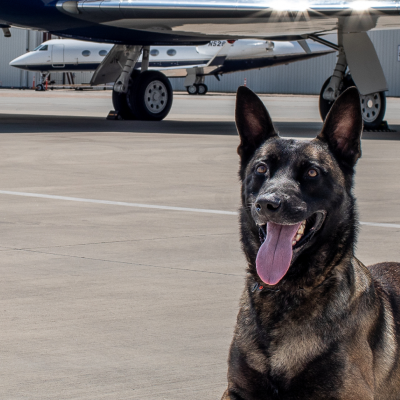What’s the difference between a working dog and a standard house pet?
You may be wondering what makes a dog a “working dog”. While this can be defined as simply as an animal with a job to do on a consistent basis; it also has a lot to do with the breed.
The American Kennel Club recognizes select breeds as part of a Working Group; meaning these breeds excel at jobs such as herding, hunting, protection, rescue, and pulling sleds. Some of the breeds that belong to this group are:
- German Shepherds
- Siberian Huskies
- Belgian Malinois
- Doberman Pinschers
- Great Pyrenees
- Cane Corsos
- And many more
These breeds thrive when they have a task to accomplish every day. This level of activity separates them from house pets or lap dogs. Not only do working dogs love to work: they NEED to work. It’s in their breeding. Just like in humans, a highly active lifestyle requires a very different diet than a more sedentary lifestyle.
What a Working Dog Diet Should Look Like
Hydration
There are a handful of key things to remember when fueling a working dog. The first and arguably most important being hydration. Dogs do not sweat but they do lose water during activity and in the heat like humans. Instead of sweating, they lose water through their tongues and the pads of their feet. It is incredibly important to keep your dog hydrated on and off the job.
Volume
Naturally larger or more active dogs need to consume higher volumes of food than smaller or inactive dogs. It is important to pay attention to your dog and their lifestyle to ensure you are feeding them enough each day. Days of extreme hot or cold can increase your dog’s caloric need due to the extra strain on their bodies to regulate temperature.
Frequency
Dogs do not often require 3 meals a day the way we are used to as humans. Most dogs can eat once a day but a dog with a physically demanding job may require 2 meals. It is important to feed your dog a significant amount of their required calories 6-12 hours before they are expected to work. Dog’s bodies work differently than ours and need this time to process the food and fuel their bodies.
You also should not feed your dog sooner than 30-60 minutes after they have been working.
Macr
os
Many dog owners around the world would stop their diet research at hydration, volume, and frequency but that would be a mistake. Giving your dog 1-2 bowls of kibble a day may not be in your dog’s best interest. Just like you think about how much protein, fat and carbs your body needs to perform well and feel good, consider these same things for your dog. You are asking them to complete a job after all and you want them to be successful.
-
Protein
Protein is a crucial part of a working dog’s diet because it improves muscle strength and helps to reduce injuries. When feeding your dog, focus on whole proteins like fish, chicken, duck, liver and eggs.
Salmon is a great source of protein as well as vitamins. Sardines have soft digestible bones that give your dog some added calcium. Consider giving your dog raw, unsalted peanut butter for a protein boost.
For highly active dogs, consider incorporating some pork. It has amino acids, protein and is more calorically dense than other meats.
-
Fats
Healthy fats help to sustain energy over a long period of time rather than burning off quickly like carbs. Fat also burns rather efficiently and can increase endurance. For a dog with a full day of work, carefully consider the kind of fats you incorporate in their meals. It is recommended that 40-50% of your dog’s diet come from fats.
Healthy sources of fat for dogs include whole grains like oats and quinoa. Peanut butter is another great option offering fat and protein. Most forms of animal fat are also excellent for your dog.
While things like avocados and macadamia nuts are excellent sources of fats for humans, they are toxic to dogs. A healthy dog diet can look very similar to a healthy human diet but it is crucial to know the differences.
-
Carbs
Carbs provide a burst of energy that does not tend to last long. Because of the recommendation that you feed them 6-12 hours before they do highly physical activities and the way that dogs digest, carbs don’t play as big of a role as fats and proteins. However, they can make for delightful treats or to add a few additional calories to your pet’s meal.
Sweet potatoes, peas, carrots, celery and green beans can all be included in your dog’s meals in moderation. Some foods that make great low-calorie treats are cantaloupe, cucumber, banana, and watermelon.
You can prepare homemade meals for your dog out of any of the foods recommended above. There are also lots of natural dog food brands available to you. The most important thing to remember is that your dog gives their energy for you every day and you should be working equally hard to fuel them for success.


